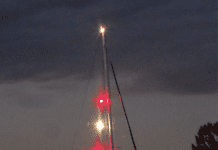
Since the time that cotton was first cultivated in ancient Mexico in 5700 B.C., netting came only in cotton’s natural color, which is a very nice white. Fabric for clothing was dyed. But for fish nets; gladiators’ combat nets; shopping satchels; traps to catch wild birds and tigers; tennis nets; hammocks; nets in cheap bars on which glass fishing floats and other junk are carelessly hung…you name it, nobody bothered to dye it. Besides, most dyes weaken the fibers, and neither circus aerialists nor cargo handlers cotton to that.
Cotton got wildly popular after Eli Whitney invented the cotton gin in 1793. (Did you know that the word “gin” is short for “engine”?)
When yachts came along, cotton netting soon came aboard either to keep sails from blowing off the bow during headsail changes (on racing boats) or to keep the tads from rolling off (on family cruising boats). The latter are occasionally identified as “baby boats.”
Netting like this is laced between the toerail and the lifeline, on boats with a single lifeline. It’s easiest done on boats with aluminum toerails. Boats equipped with double lifelines generally don’t need the netting.
All this preamble because Johnson Marine has introduced a new product. The aforementioned colored netting is not going to produce the slightest frisson. It comes in white, blue, yellow (might look great on a boat like a Cherubini ketch with bronze hardware), green (on a boat with lots of mildew); sand, and black (The Bomb, as they say these days, on any old C&C with black anodized hardware).
Johnson’s netting is made from high tenacity polypropylene (HTPP), 2″ x 2″ woven mesh, with lacing thread in a matching color. In stock form it’s 26″ high in 10, 20 or 40-foot lengths. (Custom sizes are available, but take a couple of weeks to order.)
So what’s the cost? About $6 a foot for the 10′ pieces, a bit less for the longer ones. This heavy, high-quality netting is almost twice as costly as ordinary nylon netting, which comes only in white, a very traditional yachting color.
But bearing in mind what the obscure Irish authoress, Margaret Wolfe Hungerford, said in her 1878 novel Molly Brown: “Beauty is in the eye of the beholder,” you may want to take a look at the colorful stuff in Johnson Marine’s catalog.
Contact – Johnson Marine, 860/873-8697, www.csjohnson.com.









































